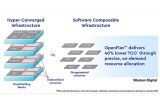Western Digital Unveils the Future of Data Infrastructure

Western Digital Corp. (NASDAQ: WDC) unveiled a comprehensive set of open standards, architecture and products to address the ever-increasing demands of high-scale private and public cloud data centers. In addition to introducing new OpenFlex™ architecture and product line, the company announced its plans to deliver an application programming interface (API) and key product specifications to the open community to create a complete foundation for open, software composable infrastructure (SCI). By delivering solutions that enable the independent scaling of compute, storage and network resources that can be quickly orchestrated, SCI enables new levels of scalability, efficiency, agility and performance.
The elements of today's announcement include:
- The Kingfish™ open API for orchestrating and managing SCI
- Open product mechanical specifications to enable vendor neutral solutions
- OpenFlex architecture and initial partner ecosystem
- OpenFlex product line of flash and disk NVMe™-over-Fabric (NVMf) devices
The exponential growth in data is not only fueling new Big Data and Fast Data applications, it is also creating complexities in the way that data is being captured, preserved, accessed and transformed. With large data sets being shared across diverse applications throughout an extended lifecycle, the dynamic nature of these more demanding, high-scale workloads is exceeding the limits of traditional data infrastructure.
Built on industry standard NVMf technology, Western Digital's OpenFlex architecture creates independently scalable pools of flash and disk that can be connected to computing resources via common networking technologies, such as Ethernet. The Kingfish API enables the flash and disk pools to be presented as software composable infrastructure that can be quickly and easily orchestrated into logical application servers. When compared to hyperconverged infrastructure (HCIs), which has fixed ratios of compute, storage and networking, the OpenFlex architecture and products can reduce total cost of ownership by up to 40 percent1 by eliminating underutilized resources. The fine-grain scalability of OpenFlex can also reduce initial infrastructure investment by nearly 50 percent2. Additionally, with the disaggregated resources being directly connected, application performance can be more predictable since the logical servers are less susceptible to "noisy neighbor" workloads that compete for the same resources or data paths.
"Data centers need a more efficient approach to satisfying the needs of complex and dynamic applications and data workflows," said Phil Bullinger, senior vice president and general manager of Data Center Systems at Western Digital. "To ensure flexibility, data center operators also need open solutions that enable them to select from best-in-class, vendor neutral options. Western Digital's OpenFlex architecture and products, and our commitment to the open community help satisfy these needs, while delivering significant improvements in cost and agility. We're building on our proven leadership in disk, flash and NVMe storage products to deliver the future of data infrastructure."
According to a recent survey by IDC of mid-sized and large-enterprise IT users3, less than half of their available compute and storage capacity is being utilized. In response to dynamic workload demands, 70 percent of users reported inefficiencies in the time it takes them to provision compute and storage resources.
"To keep up with rapidly changing application workloads, data center managers must try to build flexible infrastructures with inflexible building blocks. Storage and compute are often added to increase performance and capacity, yet end up hugely underutilized, resulting in a lot of unnecessary cost," said Ashish Nadkarni, Group VP, Infrastructure Systems, Platforms and Technologies, IDC. "Western Digital's OpenFlex architecture provides flexible composability that maximizes resource utilization in a highly scalable and flexible way, as well as eliminates the problems of 'stranded storage'. In addition, its openness eliminates the 'locked in' barrier faced by proprietary infrastructures and paves the way for broader ecosystem engagement."
Western Digital's introduction of the Kingfish API and providing of product specifications to the community to enable vendor neutral and plug compatible solutions, further demonstrates the company's commitment to open architectures. At the time of this announcement, the OpenFlex architecture leverages a broad ecosystem of data center hardware and software offerings that includes: Apache Hadoop®, Apache Spark™, Apache Kafka®, Apache Cassandra®, Apache Mesos®, Broadcom, Ceph™, DriveScale, Hewlett Packard Enterprise (HPE), Inspur, Kaminario, Kubernetes®, Marvell®, Mellanox Technologies, Microsoft SQL Server®, Percona, and Super Micro Computer.
OpenFlex Fabric Products Deliver Highly Scalable Performance and Capacity
Western Digital's family of OpenFlex fabric-attached products will be offered in a variety of performance levels and capacities to enable data center architects and IT managers to purpose-build a scalable and flexible data center for their unique needs. Highlights include:
- OpenFlex™ F3000 Series Fabric Device: For performance intensive Fast Data applications. Available in capacities up to 61TB4, it delivers low-latency NVMe flash performance over two 50Gb5 Ethernet ports.
- OpenFlex ™ E3000 Series Fabric Enclosure: A 3U enclosure that houses up to ten hot swappable F3000 fabric devices.
- OpenFlex™ D3000 Series Fabric Device: For capacity intensive Big Data applications. The 1U device offers up to 168TB of hard disk capacity over two 25Gb Ethernet ports.
The OpenFlex F3000 fabric device and OpenFlex E3000 enclosure will be available in the fourth quarter of calendar 2018. The OpenFlex D3000 fabric device will be available in 2019.
Source of information
Western Digital & Profibusiness.world
Date
August 26, 2018
